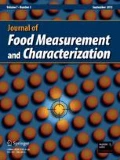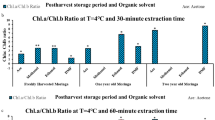Abstract
Blueberries have a high commercial value on the international market but deteriorate rapidly after harvest, which is caused by high temperature and humidity. In the present work, the effects of high CO2 (25%) were evaluated at 0 °C for 35 days on the quality and Antioxidant capacity (AC) of blueberries (Vaccinium spp.). The results indicated that 25% CO2 treatment significantly delayed the respiration rate and preserved the aroma compounds. Meanwhile, the levels of aldehydes and limonene were enhanced, but esters and ethanol contents were decreased by 25% CO2-treated. In addition, the activity of the enzymes (Peroxidase (POD), Catalase (CAT) and Superoxide dismutase (SOD)) was promoted, while 25% CO2-treated inhibited Ascorbate peroxidase (APX) activity. Simutanously, 25% CO2 increased the accumulation of antioxidants (Total phenolic [TPC], flavonoid, Ascorbic acid [AsA] and Glutathione [GSH]), and the free radical-scavenging capacity (hydroxyl (·OH) and 1, 1-Diphenyl-2-picrylhydrazyl (DPPH)) was also enhanced. This study showed that high CO2 could maintain the quality of blueberries by inhibiting respiration as well as maintaining the aroma and AC.



Similar content being viewed by others
Abbreviations
- AC:
-
Antioxidant capacity
- POD:
-
Peroxidase
- CAT:
-
Catalase
- SOD:
-
Superoxide dismutase
- APX:
-
Ascorbate peroxidase
- TPC:
-
Total phenolic
- AsA:
-
Ascorbic acid
- GSH:
-
Glutathione
- ·OH:
-
Hydroxyl
- DPPH:
-
1, 1-Diphenyl-2-picrylhydrazyl
- 1-MCP:
-
1-Methlcyclopropene
- MAP:
-
Modified atmosphere packaging
- CA:
-
Controlled atmosphere
- CSP:
-
Chelator-soluble pectins
- CK:
-
Control
- TCA:
-
Trichloroacetic acid
- DTNB:
-
5, 5’-Dithiobis-(2-nitrobenzoic acid)
- EDTA-Na2 :
-
Ethylenediaminetetraacetic acid disodium salt
- PVP:
-
Polyvinyl pyrrolidone
- GC–MS:
-
Gas chromatography–mass spectrometry
- EDTA:
-
Ethylenediaminetetraacetic acid
- NBT:
-
Nitrotetrazolium blue chloride
- PBS:
-
Phosphate buffer solution
- ANOVA:
-
One-way analysis of variance
- MVS:
-
Major volatile substances
- PUFA:
-
Polyunsaturated fatty acid
- ROS:
-
Reactive oxygen species
References
S. Tao, H. Chu, X. Chen, H. Yuan, L. Qiu, L. Zhao, D. Yan, B. Zheng, Study of the effects of 1-MCP to blueberry under cold storage. IOP conference series: earth and environmental science 61, 012041 (2017)
C.C. Neto, Cranberry and blueberry: evidence for protective effects against cancer and vascular diseases. Mol. Nutr. Food Res. 51(6), 652–664 (2007)
A. Basu, M. Rhone, T.J. Lyons, Berries: emerging impact on cardiovascular health. Nutr. Rev. 68(3), 168–177 (2010)
M.I. Sweeney, W. Kalt, S.L. MacKinnon, J. Ashby, K.T. Gottschall-Pass, Feeding rats diets enriched in lowbush blueberry for six weeks decreases ischemiainduced brain damage. Nutr. Neurosci. 5(6), 427–431 (2002)
H. Wang, X. Xia, L. An, Metabolomics analysis reveals the mechanism of hydrogen cyanamide in promoting flower bud break in blueberry. Agronomy 11, 102 (2021)
S.J. Duthie, A.M. Jenkinson, A. Crozier, W. Mullen, L. Pirie, J. Kyle, G.G. Duthie, The effects of cranberry juice consumption on antioxidant status and biomarkers relating to heart disease and cancer in healthy human volunteers. Eur. J. Nutr. 45(2), 113–122 (2006)
G. Cocetta, M. Rossoni, C. Gardana, I. Mignani, A. Ferrante, A. Spinardi, Methyl jasmonate affects phenolic metabolism and gene expression in blueberry (Vaccinium corymbosum). Physiol. Plant. 153(2), 269–283 (2015)
N. Tabakoglu, H. Karaca, Effects of ozone-enriched storage atmosphere on postharvest quality of black mulberry fruits (Morus nigra L.). LWT Food Sci. Technol. 92, 276–281 (2018)
C. Peano, R. Briano, N.R. Giuggioli, V. Girgenti, F. Sottile, Evolution of qualitative characteristics during blueberry fruit storage in a modified atmosphere. Acta Hortic. 1071, 343–348 (2015)
M. Blanch, R. Rosales, L. Goya, M.T. Sanchez-Ballesta, M.I. Escribano, C. Merodio, NADP-malic enzyme and glutathione reductase contribute to glutathione regeneration in Fragaria vesca fruit treated with protective high CO2 concentrations. Postharvest Biol. Technol. 86(8), 431–436 (2013)
S.H. Yong, J.H. Min, D.Y. Kim, G.K. Jin, D.J. Huber, Potential mechanisms associated with strawberry fruit firmness increases mediated by elevated pCO2. Hortic. Environ. Biotechnol. 53(1), 41–48 (2012)
C. Duarte, M. Guerra, P. Daniel, A.L. Camelo, A. Yommi, Quality changes of highbush blueberries fruit stored in CA with different CO2 levels. J. Food Sci. 74(4), S154 (2009)
M. J. Serradilla, M. del C. Villalobos, A. Hernández, A. Martín, M. Lozano, M. de G. Córdoba, Study of microbiological quality of controlled atmosphere packaged ‘Ambrunés’ sweet cherries and subsequent shelf-life. Int. J. Food Microbiol. 166(1), 85–92 (2013)
S. Ali, A.S. Khan, A.U. Malik, M. Shahid, Effect of controlled atmosphere storage on pericarp browning, bioactive compounds and antioxidant enzymes of litchi fruits. Food Chem. 206, 18–29 (2016)
G. Gunes, C.B. Watkins, J.H. Hotchkiss, Physiological responses of fresh-cut apple slices under high CO2 and low O2 partial pressures. Postharvest Biol. Technol. 22(3), 197–204 (2001)
S. Schwimmer, W.J. Weston, Onion flavor and odor, enzymatic development of pyruvic acid in onion as a measure of pungency. J. Agric. Food Chem. 9(4), 301–304 (2002)
X. Yang, W. Hu, Z. Xiu, A. Jiang, X. Yang, S.Y. Jia, Y. Guan, K. Feng, Comparison of northeast sauerkraut fermentation between single lactic acid bacteria strains and traditional fermentation. Food Res. Int. 137, 109553 (2020)
A. Pirie, M.G. Mullins, Changes in anthocyanin and phenolics content of grapevine leaf and fruit tissues treated with sucrose, nitrate, and abscisic acid. Plant Physiol. 58(4), 472–486 (1976)
H.H. Jia, B.P. Han, J. Lin, Y.M. Qin, The determination of ascorbic acid by indirect spectrophotometry. Chem. Ind. Times 20(12), 34–36 (2006)
J.M. Chen, L. Zhou, Several methods of detected glutathione. Shandong Food Ferment. 03, 26–29 (2007)
F.H. Zhou, A.L. Jiang, K. Feng, S.T. Gu, D.Y. Xue, W.Z. Hu, Effect of methyl jasmonate on wound healing and resistance in fresh-cut potato cubes. Postharvest Biol. Technol. 157, 110958 (2019)
C. Garcı́a-Limones, A. Hervás, J.A. Navas-Cortés, R.M. Jiménez-Dı́Az, M. Tena, Induction of an antioxidant enzyme system and other oxidative stress markers associated with compatible and incompatible interactions between chickpea (Cicer arietinum L.) and Fusarium oxysporum f. sp. ciceris. Physiol. Mol. Plant Pathol. 61(6), 325–337 (2002)
Q. Zheng, J. Zuo, S. Gu, L. Gao, W. Hu, Q. Wang, A. Jiang, Putrescine treatment reduces yellowing during senescence of broccoli (Brassica oleracea L. var. italica). Postharvest Biol. Technol. 152, 29-35. (2019)
W. Yi, X. Wu, R. Cao, H. Song, L. Ma, Biological evaluations of novel vitamin C esters as mushroom tyrosinase inhibitors and antioxidants. Food Chem. 117(3), 381–386 (2009)
A. Jiang, X. Meng, W. Hu, M. Tian, Y. Wang, Effects of high CO2 shock treatment on physiological metabolism and quality of postharvest blueberry fruits. Transact. Chinese Soc. Agric. Eng. 27(3), 362–368 (2011)
N. Falagán, L.A. Terry, Recent advances in controlled and modified atmosphere of fresh produce. Johnson Matthey Technol. Rev. 62(1), 107–117 (2018)
K. Apel, H. Hirt, Reactive oxygen species: metabolism, oxidative stress, and signal transduction. Annu. Rev. Plant Biol. 55(1), 373–399 (2004)
A.S. Chauhan, L. Zhuang, B. Gan, Antagonism between antiviral signaling and glycolysis. Trends Endocrinol. Metab. 30, 9 (2019)
J. Goliáš, A. Němcová, A. Čaněk, D. Kolenčíková, Storage of sweet cherries in low oxygen and high carbon dioxide atmospheres. Hortic. Sci. 34(1), 26–34 (2008)
A.L. Jiang, H.D. Gao, W.Z. Hu, S.T. Gu, H.F. Jiang, Research progress of effects of high-concentration CO2 modified atmosphere on the physiological metabolism and ultrastructure of berry. Packaging Eng. 39(09), 96–101 (2018)
P. Ji, C.B. Wang, Q. Wang, L.J. Pang, A.Y. Sun, Quality and physiological changes of blueberry under low temperature and controlled atmosphere storage. Anhui Agri. Sci. Bull. 24(24), 19–21 (2018)
J. Goliáš, J. Létal, O. Veselý, Effect of low oxygen and high carbon dioxide atmospheres on the formation of volatiles during storage of two sweet cherry cultivars. Hortic. Sci. 39(4), 172–180 (2012)
M. Blanch, I. Álvarez, M.T. Sanchez-Ballestaa, M.I. Escribanoa, C. Merodioa, Involvement of fatty acids in the response to high CO2 and low temperature in harvested strawberries. Postharvest Biol. Technol. 147, 196–205 (2019)
J. Song, F. Bangerth, The effect of harvest date on aroma compound production from ‘Golden Delicious’ apple fruit and relationship to respiration and ethylene production. Postharvest Biol. Technol. 8(4), 259–269 (1996)
O.J. Caleb, P.V. Mahajan, M. Manley, U.L. Opara, Evaluation of parameters affecting modified atmosphere packaging engineering design for pomegranate arils. Int. J. Food Sci. Technol. 48(11), 2315–2323 (2013)
J. Yan, Y. Song, J. Li, W. Jiang, Forced-air precooling treatment enhanced antioxidant capacities of apricots. J. Food Process. Pres. 42(1), e13320 (2018)
J. Shi, J. Zuo, F. Zhou, L. Gao, Q. Wang, A. Jiang, Low-temperature conditioning enhances chilling tolerance and reduces damage in cold-stored eggplant (Solanum melongena L.) fruit. Postharvest Biol. Technol. 141, 33–38 (2018)
T. Dong, J. Shi, C.Z. Jiang, Y. Feng, Y. Cao, Q. Wang, A short-term carbon dioxide treatment inhibits the browning of fresh-cut burdock. Postharvest Biol. Technol. 110, 96–102 (2015)
T. Deuchande, S.M.P. Carvalho, J. Giné-Bordonaba, M.W. Vasconcelos, C. Larrigaudière, Transcriptional and biochemical regulation of internal browning disorder in ‘Rocha’ pear as affected by O2 and CO2 concentrations. Postharvest Biol. Technol. 132, 15–22 (2017)
J. Sun, H. Lin, S. Zhang, Y. Lin, H. Wang, M. Lin, Y. Hung, Y. Chen, The roles of ROS production-scavenging system in Lasiodiplodia theobromae (Pat.) Griff. and Maubl.-induced pericarp browning and disease development of harvested longan fruit. Food Chem. 247, 16–22 (2018)
R. Mittler, Oxidative stress, antioxidants and stress tolerance. Trends Plant Sci. 7(9), 405–410 (2002)
J.C. Pennycooke, S. Cox, C. Stushnoff, Relationship of cold acclimation, totalphenol content and antioxidant capacity with chilling tolerance in petunia (Petunia hybrida). Environ. Exp. Bot. 53, 225–232 (2005)
H. Wang, W. Zhi, H.X. Qu, H.T. Lin, Y.M. Jiang, Application of α-aminoisobutyric acid and β-aminoisobutyric acid inhibits pericarp browning of harvested longan fruit. Chem. Cent. J. 9, 54 (2015)
S. Kumari, M. Agrawal, S. Tiwari, Impact of elevated CO2 and elevated O3 on Beta vulgaris, L.: pigments, metabolites, antioxidants, growth and yield. Environ. Pollut. 174(5), 279–288 (2013)
L. Wang, H. Zhang, P. Jin, X. Guo, Y. Li, C. Fan, J. Wang, Y.H. Zheng, Enhancement of storage quality and antioxidant capacity of harvested sweet cherry fruit by immersion with β-aminobutyric acid. Postharvest Biol. Technol. 118, 71–78 (2016)
Acknowledgements
This study was supported by the ‘Thirteenth Five-Year Plan’ for National Key Research and Development Program (Grant No. 2016YFD0400903).
Author information
Authors and Affiliations
Corresponding authors
Additional information
Publisher's Note
Springer Nature remains neutral with regard to jurisdictional claims in published maps and institutional affiliations.
Rights and permissions
About this article
Cite this article
Gao, H., Hu, W., Jiang, A. et al. Effects of high CO2 on the quality and antioxidant capacity of postharvest blueberries (Vaccinium spp.). Food Measure 15, 5735–5743 (2021). https://doi.org/10.1007/s11694-021-01062-x
Received:
Accepted:
Published:
Issue Date:
DOI: https://doi.org/10.1007/s11694-021-01062-x




